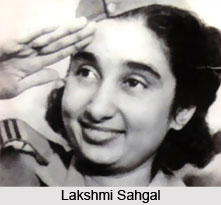The Rani of Jhansi Regiment was the Women`s Regiment of the Indian National Army, also known as the Azad Hind Fauj, under the leadership of Netaji Subhas Chandra Bose. The Indian National Army was an armed force established in the year 1942 by Indian nationalists in Southeast Asia during the Second World War. The main objective of the army was to attain Indian independence from the dominion of the British Empire in India, with the support of the Japanese Forces. The unit of Rani of Jhansi Regiment was led by Captain Lakshmi Sahgal, also known as Lakshmi Swaminathan. The regiment was founded in July 1943 and comprised of volunteers from the emigrant Indian populace in South East Asia.
 Establishment of Rani of Jhansi Regiment
Establishment of Rani of Jhansi Regiment
Most of the members of the Rani of Jhansi Regiment were teenage women volunteers of Indian descent from Malayan rubber estates. Only a small fragment of the members of the regiment had ever been to India. The initial basis of the armed women`s force was formed with the training camp of the regiment which was located in Singapore. During that time there were around one hundred and seventy cadets in the unit. The cadets were provided ranks of non-commissioned privates or officers based on their education and skills. Eventually other camps of the Rani of Jhansi Regiment were also developed in Bangkok and Rangoon. By November 1943, the armed women`s unit comprised of around 300 cadets.
Training of Rani of Jhansi Regiment
The women, who were recruited in the Rani of Jhansi Regiment, were segregated into platoons and sections. They were also given different ranks of Non-Commissioned Officers and Sepoys based on their various skills and their educational qualifications. The cadets of this unit undertook various military and combat technique training, which also included route marches, drills, weapons training in rifles and other fire arms, hand grenades, as well as bayonet charges. A number of outstanding cadets were also selected for further advanced training in jungle warfare, which was conducted in Burma. Around five hundred cadets of the Rani of Jhansi Regiment were the first qualified troops who passed out in March 1944 from the training camp in Singapore. Morever around two hundred cadets of the unit were also selected for training in nursing, which led to the formation of the Chand Bibi Nursing Corps.
Service of Rani of Jhansi Regiment
During the campaign of the Indian National Army (INA) in Imphal, an initial contingent of the Rani of Jhansi Regiment, comprising around one hundred of the troops, moved to Maymyo. A part of the contingent was planned to form a front line unit which was to enter the Gangetic plains of Bengal after the anticipated fall of Imphal. A part of the Rani of Jhansi Regiment was also included in the Nursing corps at the Indian National Army hospital located at Maymyo. After the failure of the besiegement of Imphal and the unfortunate retreat of the soldiers of the Indian National Army, the Rani of Jhansi Regiment troops were tasked with coordination of relief and care for the soldiers of the Indian National Army who went to Maymyo and Monywa and were not utilised in battle.
Ending of Rani of Jhansi Regiment
After the collapse of Rangoon and the withdrawal of Subhas Chandra Bose and the Azad Hind provisional government from the territory, the soldiers who were initially from Burma were permitted to disperse. The rest of the regiment recoiled, along with the receding Japanese forces, on foot as well as mechanical transport whenever available. During the retreat, the troops of the Indian National Army and the Rani of Jhansi Regiment experienced attacks from the resistance forces, as well as Allied air attacks. Later the unit was disbanded.






































